3 simple steps to find your ideal client
Would you love to find your ideal client? Here are 3 steps that will increase your chances, no matter the size of your business.
1. Who are they? Identify your ideal client
This first step was suggested to me by a fellow copywriter and friend a few years back. We were sitting having dinner one evening. I was bemoaning my lack of work, and so she suggested that I write a profile of my ideal client. She told me to think about exactly what he or she might look like. What kind of work does he do? What are his likes and dislikes? What does he want, expect, and hope for in life and work?
I was skeptical about how writing a list might help. But it couldn’t hurt to try, I reasoned, so I sat down and made a list, giving as much detail as I could. From the kind of work he did to the radio station he listened to, the number of children he had and his keep-fit habits – I listed everything. I then gave it no more thought.
Now, it could be pure coincidence, or it could be some magnetic vibe I sent out into the universe, but the very next evening I received an out-of-the-blue invitation to connect on LinkedIn, which I accepted graciously adding a message asking if and how I could help. To cut a long story short, that LinkedIn member is now one of my favourite customers. He gives me plenty of work, pays on time, and is generally a pleasure to do business with.
Obviously, this strategy doesn’t come with a guarantee. And it’s foolish to think that by doing this exercise your ideal client will magically materialise but it’s worth a try, isn’t it? The idea of writing a client profile is not new. Salesmen have been using this strategy for decades to find their clients.
The idea is that it’s difficult to go looking for something if you don’t know what you’re looking for. But if you know exactly the kind of person your ideal client is then it makes the job of finding him a whole lot easier. If you have no idea where to start, think about your past successes. What kind of client did you get the best results from? Write a list of his attributes.
2. Where are they? Find out where your ideal client hangs out
Let’s say you’re looking for a manufacturer to sell your metal press machines to.
Once you’ve created a list of characteristics of the manufacturing executive, you’ll have a little more to work with. You’ll be able to surmise, based on his job, his demographic, his hobbies and his motivations, what social media platforms he uses, if he uses them, or the events he might attend. Your manufacturer might use Twitter to keep himself up-to-date on product trends. He may attend manufacturing trade shows or conferences.
Does he frequent Facebook or Twitter? Seek out companies who could become your ideal client. Follow them and start conversations. It might come to nothing, it could lead to something. You never know. Chat over coffee at a networking event or a conference.
Be generous with the people you meet in these communities because you never know who might turn out to be your ideal customer. Whether online or in person, introduce people, offer advice and support, and recommend resources and tools. If you’re a service provider, then you could offer short consultations – Rather Inventive, for example, offers free 1-hour consultation of their marketing service – it might not lead to work, but it will all help to pull people towards your business, establish you as the expert in your field and help you to get more referrals.
3. What do they want? Focus on them when marketing
When you have a clear picture of the type of customers your business should be targeting, then you can create a strategy with these ideal customers in mind, rather than wasting time and resources on unsuccessful marketing efforts. You’ll know exactly what message, product, services, sales and support you need to put across to meet his needs, wants or desires.
Once you have your ideal customer in your grasp, figure out what they value most in a relationship with a business like yours. What do you need to do so that your new client doesn’t get the wondering eye, and start looking for another supplier? Optimise whatever it is that gives you the competitive advantage.
Your ideal customer is out there, somewhere. But he’s going to be tricky to find unless you know who he is, where he hangs out and what he wants. Take a few moments to consider these and you’ll stand a much better chance of finding him.
—
Photo: Image Catalog, Writing in Notebook at Desk
Shall we take this outside?
A recent study in Australia has shown that spending time outside can significantly benefit physical and mental health. Ok, ok, I can see your eyes rolling – this is not ‘new’ news. What is new is the swathes of workers who are adapting their 9-5’s in order to embrace the great outdoors, using the benefits that nature brings to tackle work-related problems.
In our episode 9 of our podcast, Ben and Al speak to Jon Johnson, an organisation development guru who has pioneered a novel way of overcoming the metaphorical ‘brick wall’ that many of his clients face when trying to solve issues in the office. A keen mountaineer in his student days, Jon compares the notion of running a business with the idea of going on a physical journey.
When we climb to the top of a mountain, the view that greets us can offer an incredible perspective which we didn’t necessarily have at the start. In order to apply this metaphor to real-life, Jon invites his clients to join him on a walk – an actual walk – that involves some decision-making and trouble-shooting along the way but will ultimately result in a great view and a much clearer perspective on the business issues in question.
This concept is not dissimilar to the global movement, Street Wisdom, a social enterprise with ‘a mission to bring inspiration to every street on earth.’ These walking adventures are led by volunteer facilitators or if you can’t attend a workshop you can download the audio guide. In just three hours of walking and wandering, participants have ‘resolved problems that have dogged them for years, found new business ideas, changed careers, discovered new directions, and learned how to deal differently with living, learning and loving.’
Research shows that increasing urbanisation has led to cities becoming ‘epicentres for chronic, non-communicable physical and mental health conditions’. Green spaces are crucial in combatting the health threats that urban lifestyles pose. And for those of us stuck in sedentary jobs, it has been proven that by visiting outdoor, green spaces for 30 minutes or more, at least once a week, can reduce high blood pressure in a community by 9% and depression by 7%.
What are you waiting for? I’ll get my coat…
—
Photo credit: Helen Creese, Baynhams Copse
Rather Inventive’s Ultimate GIF Guide
My inbox is currently full of ‘Ultimate Gift Guides’ for just about every living object known to man; gifts for him, gifts for her, gifts for grannies, gifts for kids. Dogs, budgies and inanimate objects are now all catered for at this time of year. New offers ping in on a daily basis with alarming velocity, reminding me of my complete inadequacy as an ‘Organised Christmas Shopper’. No I haven’t started yet. And no, I don’t have a list. I don’t want to dwell on that….

…so in order to avoid the impending doom of my ‘last-minute-shopping’ future (when you spend waaaaay to much on gifts that no-one actually wants because you didn’t give yourself enough time to source anything half decent), I decided to lighten my spirits by creating the Ultimate GIF Guide (helpful blogger or procrastination at its finest?!).

Er, so – can I put a GIF in a Christmas stocking?
No! A GIF is not a gift in the physical sense of the world – it just sounds like one, minus the ‘t’. But as an avid social media user, a GIF does feel like a bit of a treat. You see, GIF is the acronym for Graphics Interchange Format, which is a very boring name for something that’s pretty cool. It refers to a file format that supports both static and animated images. They are essentially quick videos that loop and don’t require a play button.
When is a GIF not a GIF?
GIFs are soundless, play in a loop and are typically just a few seconds long. Videos, by comparison are usually longer with sound or music.
What do I use a GIF for?
As well as spreading a little light-hearted cheer, GIFs can be used quite cleverly across your social media platforms. Like emojis, some GIFs allow you to be a bit more playful with your tone of voice. They can also help your posts stand out amongst the tirade of tweets and pictures that appear on Twitter, Facebook and Instagram. GIFs can have a serious use, too – for instance, they are a great way of showcasing products, animating data and creating ‘how-to’ guides and tutorials. I particularly like to use them to convey a message which requires more than 140 characters as a GIF will not take up any character space on Twitter – hoorah!

We love the tutorial GIFs
over on astutegraphics.com
Sold! Now, where can I find them?
I love Giphy. It’s full-to-brimming with gorgeous GIFs to suit all needs and occasions! You will also find GIFs at Tumblr and Google Image Search (just go Google, select ‘Images’ and at the bottom of the page you’ll see ‘Advanced Settings’. Click, then click on the ‘Type’ option and select ‘Animated’).
If you’ve got a bit more time and you’re feeling creative, have a go at making your own using these tools:
Happy GIF-fing!! (don’t ever say that out loud…).
The best of Integrated Live 2016 – a Digital Marketing show
Last month I boldly travelled to the big smoke, braving commuters on the DLR and take away food for hipsters, to spend two days at Integrated Live, a digital marketing show in London’s Excel Centre.
Absorbing the latest trends in marketing from some excellent speakers, I bring back what I believe are the most important points from their talks – There is no end to my commitment to RI customers!
International Busking Day
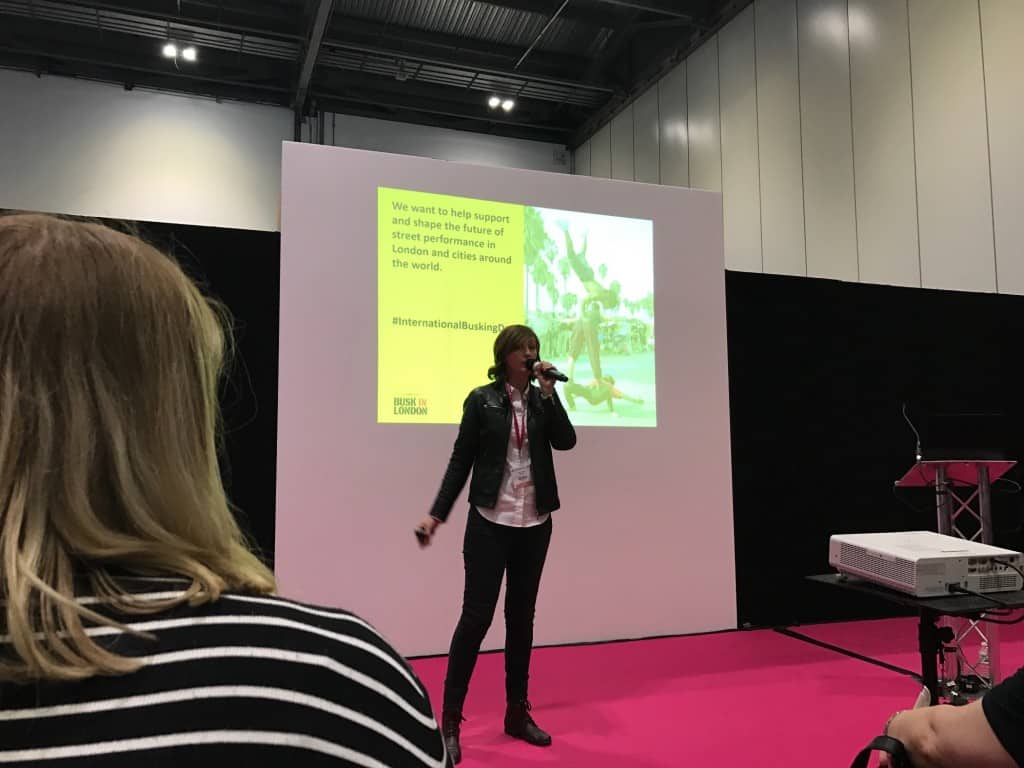
Julia Jones (@DrRockUK) – How something as simple as a hashtag could unite ordinary folk and beloved rock stars to help build momentum around a single event, International busking day.
- Use hashtags
- Get influencers involved
- Timely posting around trending topics
- Sent out a promotion package with the hashtag and instructions how to promote to others
- Keep the idea simple and easy for people to get on board
How to use the Psychology of Language to Boost ROI on paid search
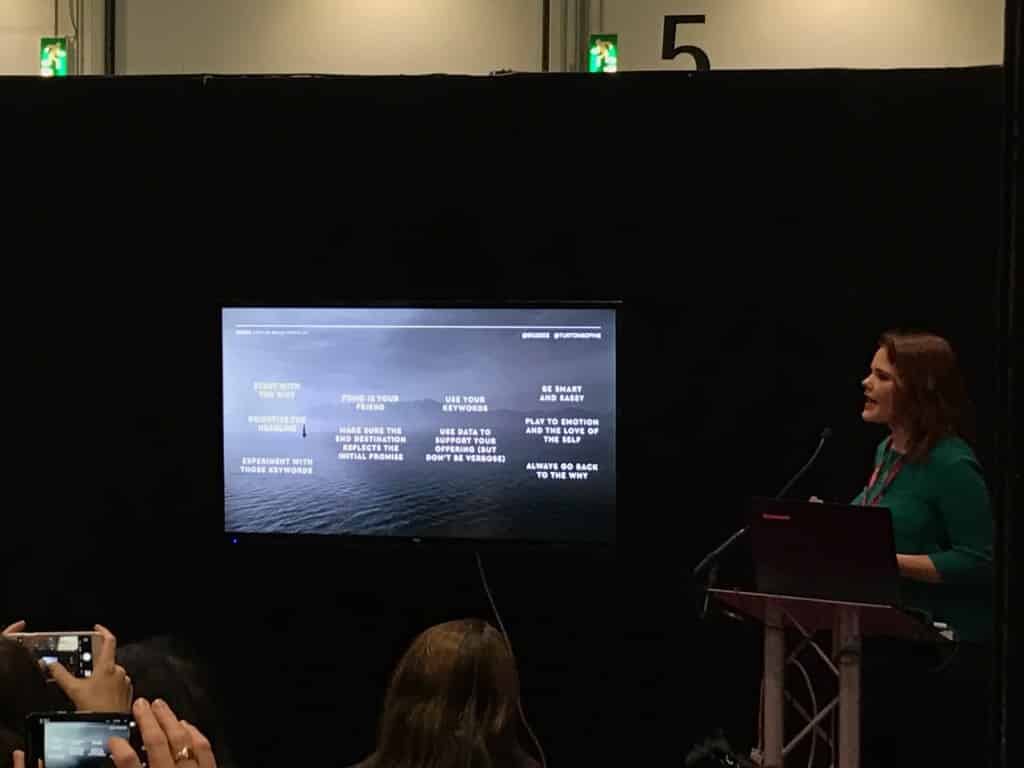
Sophie Turton (@TurtonSophie) – Tweaking the language you use to encourage more people to click through and convert on your Google Ad.
- Start with why – Simon Sinek ‘customers buy why you do it’
- Remember first and last pieces of content we see
- Include your keywords
- Solve a problem – Target the issue as well as the solution
- Customer: Think about what they love and hate and who are their best friends and enemies
- Add in reviews directly to ad content. Sometimes Google will automatically pull through reviews
- Use site links to testimonial pages
- “Most people would rather avoid loss than acquire gain”
- Insert urgency
- Add Google countdown customisation in advert – Increased CTR by 32%
- Repeated messages are more likely to believed
- Landing page (on site) must mirror advert
(A similar presentation of Sophie’s on slideshare)
What Works? – (Video) Marketing in 2017
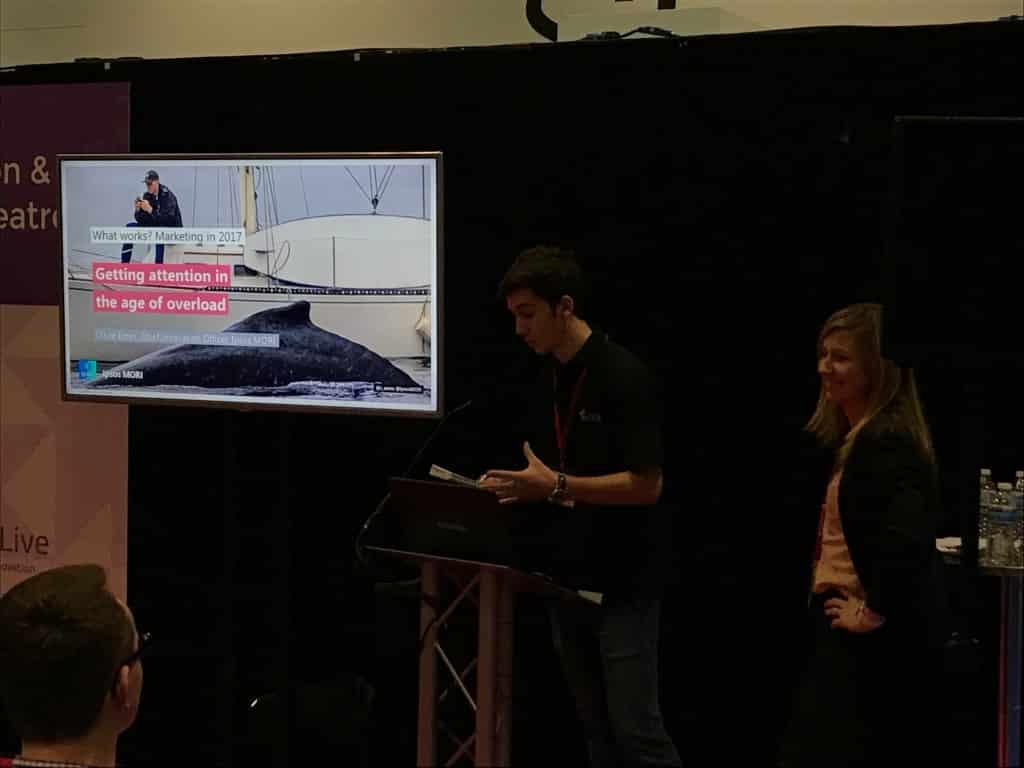
Claire Emes (@C_emes) – How to make video more effective to stop people skipping the ad or bouncing back to search.
- Attention decrease from 12 to 8 seconds – Less than a goldfish!
- If you don’t look like an ad and you won’t get skipped
- Showing your brand early in a video makes people skip, unless it’s essential to the story
- Use sound to break through as audio bigger impact than visual
- (however) 85% of Facebook ads are ‘listened to’ with the sound off – Use subtitles!
- Time matters – What’s the greatest idea in 5 seconds? Before they skip or bounce
Storytelling Content – The What, Why and How
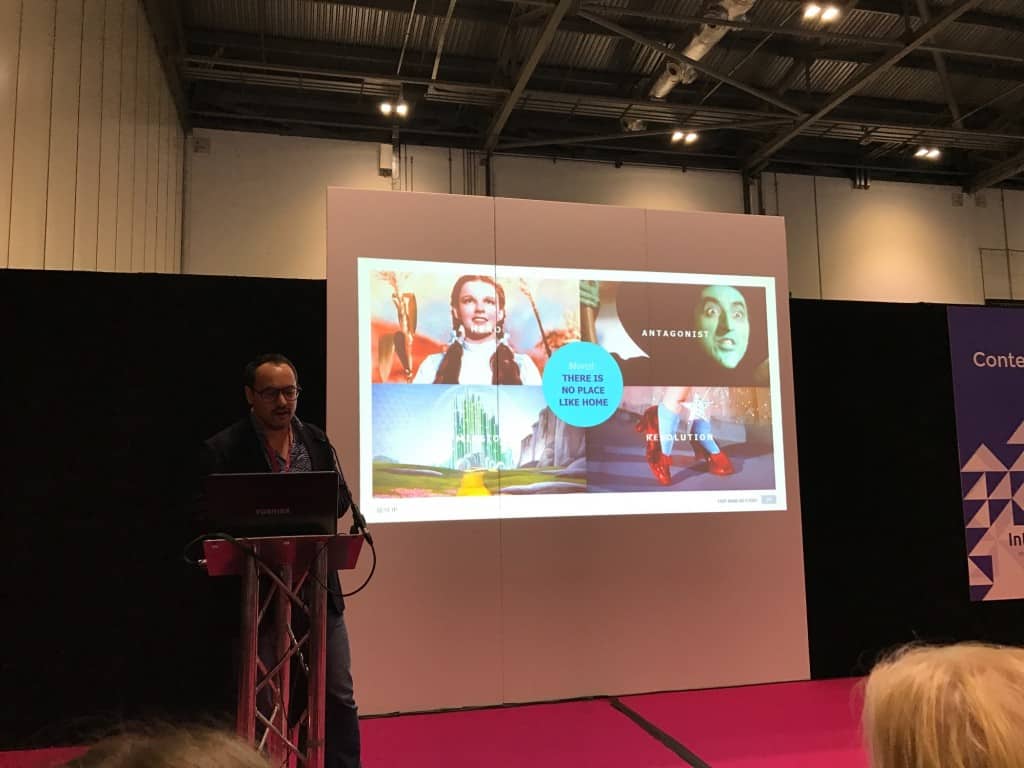
Ed Woodcock (@edwoodcock) – Brilliant presentation on how to write more compelling copy – Make it a story.
- A story needs a Hero, an Antagonist (or monster), a Mission and a Resolution
- The monster is the problem/challenge and the hero is your brand/product
- Kurt Vonnegut on the Shapes of Stories (good video, worth watching)
- All stories have a dramatic conflict (Sid Flickr) – Find the conflict!
- Embrace the dark side in story telling
Pics or it Didn’t Happen – The Power of Infographics
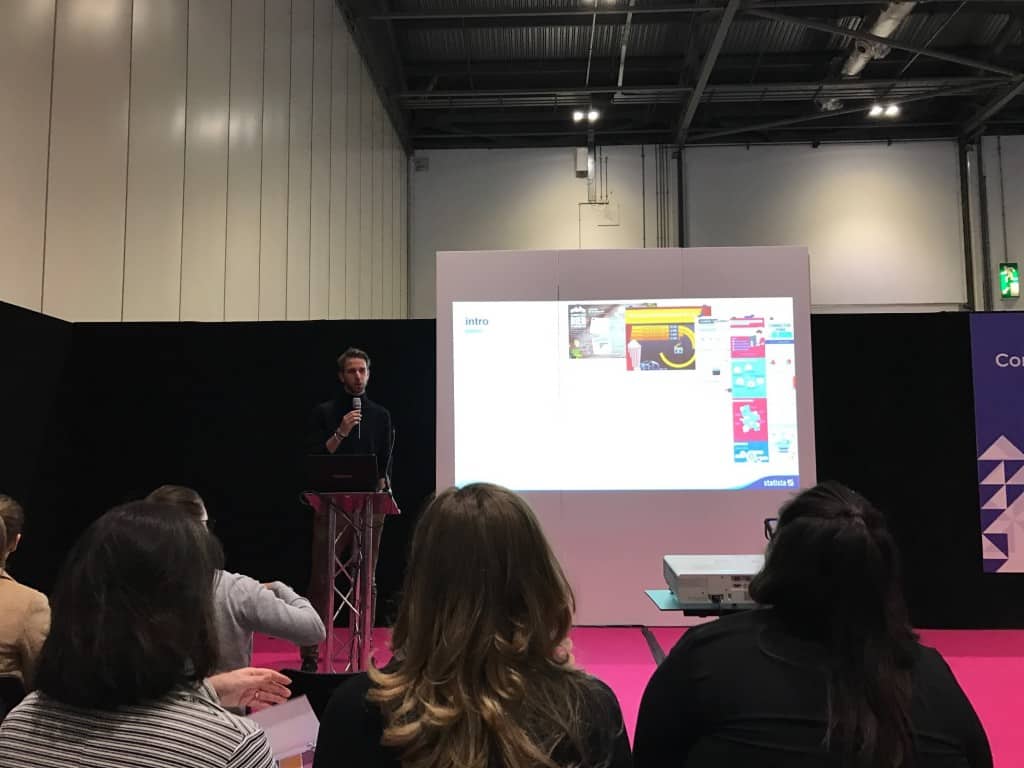
Robin Hüdepohl (@robinhuedepohl) – About combining text with visuals to make your concepts/sales pitches quick to understand and easy to remember.
- People process visual information 60,000 x faster than text
- Interplay between text and images will unfold the power of the story
A Facebook campaign, how we got results
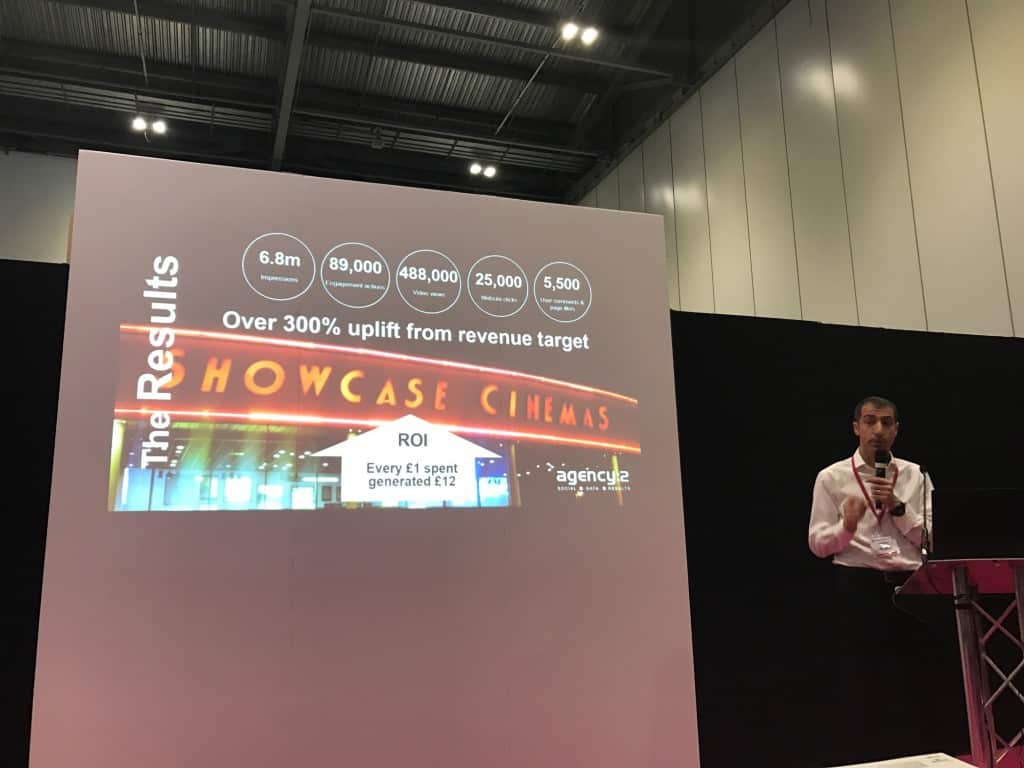
Joel Davis (@joeldavis_) – A simple breakdown of their ad campaign for the new Thomas the Tank Engine film and what worked best for them.
- Video drives sales
- The more targeted the ads, the cheaper the CPM (Cost Per iMpression)
- Ad retargeting (showing the ad to people who visited the website) is incredibly important. In Cinema example people book within 48 hours of the show
- 10-13 seconds is ideal for Facebook video
- Important numbers to track – Cost/Sale, Sales generated
- What works to drive social engagement – Ask questions, run competitions
The Rise and Rise of Editorial Video
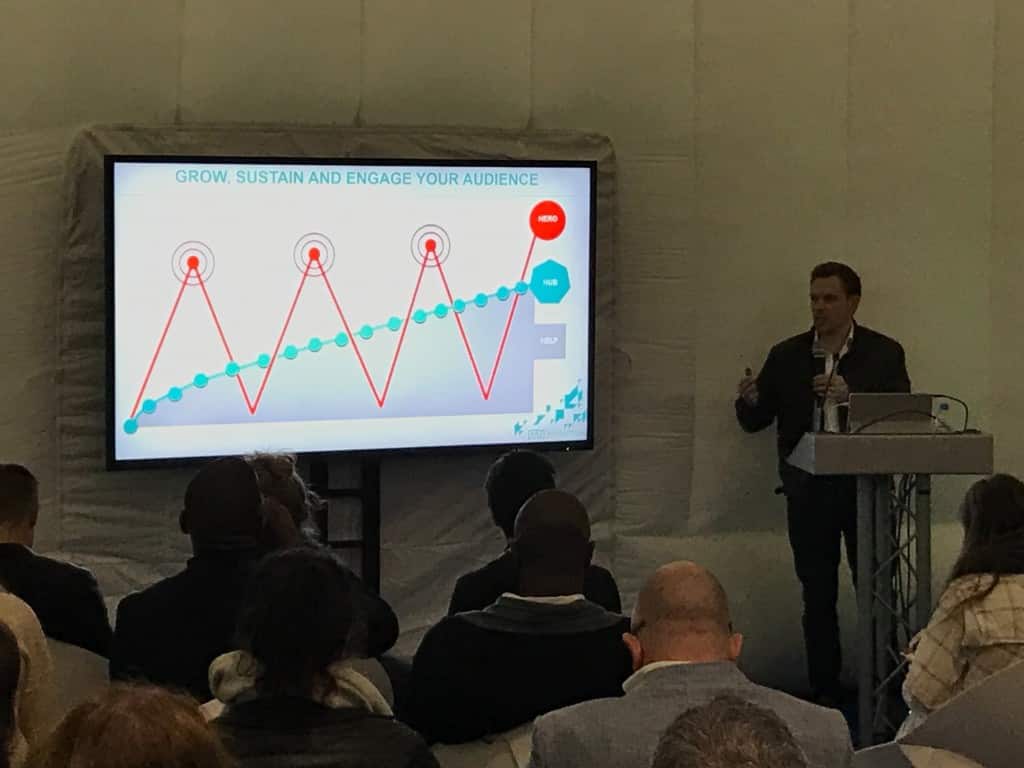
Simon Baker (@simonthebaker) – Creating video that people want to watch
- How to grow, sustain and engage an audience – Produce lots of Help content (long lasting and niche/specific). Add in Hub content (topical, short shelf life) then sprinkle with your Hero content (big ad/sales)
- Find sweet spot between audience passion and brand positioning
- Content checklist: Related to a topic?, Do you add value? Do people desire to see it? Is it right for the platform?
- Plan editorial agenda around current topics.
How to Listen: The Art of Not Making Noise
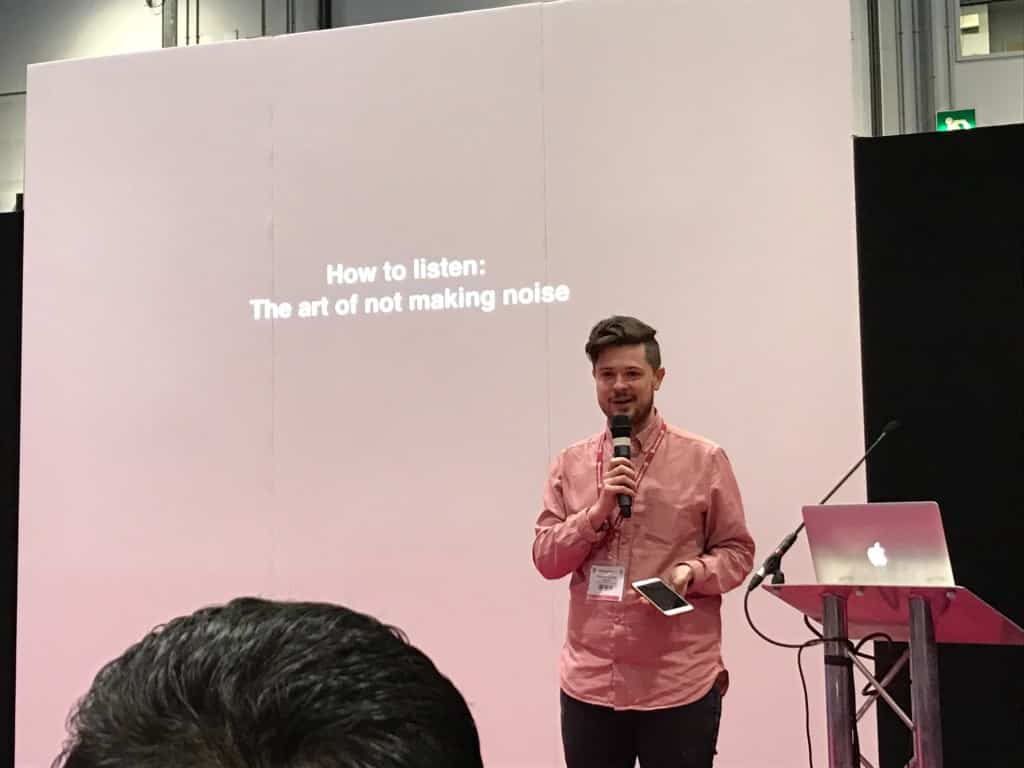
Samuel Goudie (@sgoudie) – Not only should you listen, but you should listen to people whose opinions differ from your own. Sam was an engaging speaker
- “When everyone is shouting no one is heard”
- Don’t block out opinions counter to your own. Actively seek out other people with different opinions
What is a podcast? And how to listen to one
What is a Podcast?
Ask Google what a podcast is and you will be told:
a digital audio file made available on the Internet for downloading to a computer or portable media player, typically available as a series, new instalments of which can be received by subscribers automatically.
Ostensibly, a podcast is like an on-demand radio show, with each podcast covering a variety of topics from Politics to Arthurian Legends…there really is a podcast for everyone. Some podcasts are one-offs whilst others form part of a regular series, much like TV shows.
I listen to podcasts whilst I’m driving. I listen to podcasts when I’m working at my computer. I listen to podcasts whilst I’m doing housework and I used to listen to podcasts at the gym (I ditched the gym but kept up with the podcasts!). And because of the vast array of subject areas now covered by podcast producers, as a listener, you can practically curate a customised radio station based on topics that appeal purely to your interests.
Thanks to the pause button there’s no need to sit outside work, clocking in late, whilst you wait for the end of the feature – you can simply dip in and out of the podcast as and when is convenient. What’s not to love? Did I mention that they’re free, too?!
How can I listen to a Podcast?
As long as you have access to the internet, you can listen to podcasts anywhere. And if you are going somewhere without an internet connection, you can download the podcast and listen to it later.
When I’m out and about, I will use my iPhone to listen to podcasts. Personally, I use the iPhone Podcasts App, but there are other mobile management tools available. Overcast comes highly recommended for Apple’s iOS and Pocket Casts for Android. Simply download these Apps to your smartphone and use the software’s own features to search for and listen to your podcasts. For the desktop, try iTunes or gpodder or if you’re sharing a computer, go for a web-based option such as ShortOrange or Player FM. Some tools allow you to speed up the podcast, cutting out any prolonged silences. You can also choose to subscribe to certain shows or series.
Where can I find good Podcasts?
Now you know how to listen, you just need to find a podcast that appeals to you. There are so many out there, many of which will be featured or recommended on your management tool. However, there are also some great recommendations online and in magazines. I keep a copy of Stylist Magazine’s guide in my bedside table and a friend also sent me this link to the Guardian’s recommended podcasts. iTunes boasts a fantastic podcast directory. Anybody can record a podcast – qualities will vary – but as a result of that, you will find podcasts covering all subject areas, from spin-off radio shows to social media tips and advice.
Happy podcast-hunting! To start you on your podcast journey, try some of the following for size:
- TED Radio Hour – Interviews and ideas based on TEDTalks based on a common theme
- Something Inventive – Our very own podcast with discussion and interviews on Business, Marketing and Creativity
- 99% Invisible – Looking at the littlest things in life that go unoticed
- Radio 4 Friday Night Comedy – The best new comedy from Radio 4, every week
- Planet Money – “The Economy Explained”, Fascinating and fun in equal parts
- Mac Break Weekly – Fun conversation about technology and all things Apple
Let us know your podcast recommendations on Twitter @RatherInventive – let’s spread the good word!
Great digital products don’t happen by accident
Nice presentation from David Gillis on why Great digital products don’t happen by accident given at Reactor Design Day 2014.
3 key concepts in his presentation were:
Ethos – What is your product’s voice and why will people trust it
Pathos – What do you want people to feel when they use your product
Logos – What problem is your product or service trying to solve
The following sentence jumped out to me near the end of the video
“Validate your problem first, and then figure out what success will look like for that, and then relentlessly focus on achieving that.”
I recommend you watch the video if you are at all interested in making products that people want and love.
Are you being served? Why it’s important to set customer expectations
Are you one of those people who cannot abide queuing? Do you stand there fuming and raging over the length of time you’ve been waiting, while repeatedly looking to the front of the line in the deluded hope that your venomous glares will hurry them on? If so, then you will appreciate that as a customer your experience of the company will be tainted with the frustration at having to wait for so long. But would this still be true if there was a little sign that says ‘You are 10 minutes from being served’?
Queues impact almost every industry at some point, and waiting line psychology, as explained by David Maister, shows how queues can affect our customers. Companies have long been using waiting line psychology to their advantage but it’s worth revisiting the idea that our pre-service is just as, if not more, important than our in-service provision. A long wait can suggest a lack of concern for the customer and can hint at poor service quality. Yet a queue for our service is the opportunity for us business owners to offer a glittering pre-service – the opening act before the headliner. Customers will gain a good understanding of a company’s effectiveness from the pre-service, and if they’re not happy with it, well, why should they stick around for the main act?
Set expectations
Anyone who has ever had to queue will understand that our expectations affect our experience. If we expect a queue to move quickly and it turns into a snail’s race we are left annoyed and frustrated. So, make the early stages of your customers’ experience a positive one by managing their expectations and you will win over the customer. Can you let your customer know how long they’ll have to wait before they reach the front of the queue? Ikea’s Customer Service has a number ticket system, a technique that’s been around for decades now, but it still works exceptionally well. Let your customers know what to expect.
Keep them entertained
Can you entertain customers while they wait? Distractions, or ‘service-related time fillers’ will divert your customer’s attention so the wait is not so onerous. Strategies such as a TV or reading material (think magazines in dentist waiting rooms), shops to browse at train stations, even the muzak we (are forced to) listen to when we’re waiting to speak to a service human on the telephone (which is actually more annoying to some than having to wait in silence) are all designed to keep customers occupied while they wait. Can you go one step further? An offer to call them back perhaps? Is there something they can be doing that will make the next step of your service run more smoothly, such as completing forms or providing entertainment as part of the wait? What can you offer your waiting customers?
Respond quickly
Appreciate what anxiety your customer might be feeling. Perhaps they need some acknowledgement that they’re waiting, rather than worry they’ve been forgotten or overlooked. Got an email query that you cannot deal with right away? You could send a reply that acknowledges the customer’s query and that they will be served as soon as someone is available. This takes the pressure off both the customer and you and in most cases can be automated.
Investing in your customer goes a long way. For instance, should there be a problem or a delay in your service, you could just ignore the customer, letting him wait in limbo, or you could go ‘over and above’ and take the opportunity to wow him with your efficiency. Love them or loathe them, a recent experience with Amazon left me in no doubt as to the time I should expect my delayed parcel to arrive. I appreciated their consideration immensely and forgave the delay.
Ultimately, what is most important throughout the process of dealing with customers is to manage their expectations. And every customer has expectations, from the very initial stages of his interaction with your business. If a customer is impressed with your pre-service then he’s more likely to remain your customer.
—
Photo credit: Xiaojun Deng Follow, Nairobians queuing up for a bus.
The Power Of FREE! How offering free e-books online can improve your business
There’s no such thing as a free lunch, right? Actually, sometimes there is. In fact, I was treated to one just this week. I absolutely wasn’t expecting it but boy did it feel good!
The Soft Sell: Using social media to get to 4th base
As a freelance Social Media Manager, one of my first questions to my clients is often ’what do you want to achieve from your Social Media output?’ Nine times out of ten, the answer is ‘more sales’. A relatively simple answer, yet achieving that goal can be a little more complex than tweeting pictures of products or lists of services and special offers.
The World Wide Web is a Vast Territory
Over 3 billion people use the internet (May 2015, www.time.com) and 2 billion of them are using Social Media (August 2014, www.wearesocial.com). Yet for many of us, our first ‘tweet’ is sent out to a grand total of ZERO followers, and our first blog post is probably read by exceptionally dedicated family members and friends, but not necessarily money-spending customers.
So How do we Attract that Untapped Target Market?
Take it from me, it’s not by bombarding people with links to the services that you are promoting or to a discounted product on your website. We are engaging, however virtually, with ‘real’ people, so the best way to communicate with consumers is by treating them as real people.
Don’t be the Buffet Table Bore
Imagine being at a party and someone you’ve never met before approaches you. In ‘real-life’, a few niceties would be exchanged, you’d take it in turns to ask each other questions, find out a little bit about each other, share stories that may be relevant to what you’ve learnt from your conversation. Perhaps the stranger has spent the day researching potential city breaks and you’ve recently had a fab time in Barcelona – you’ll offer tips and information on great places to visit and an awesome restaurant that serves the best tapas. It will (hopefully) be a mutually beneficial conversation. If the same person approached you and proceeded to bombard you with information about his/her life – without letting you get a word in edgeways – you’d be looking for your first excuse to make a break for the buffet table. It’s exactly the same etiquette on Social Media.
Inform, Share, Engage & Educate
In order to attract the attention of a consumer (or ‘follower’), try sharing some information. Put something out there that is useful. A café-owner may blog about the best-selling brownie on their menu; by sharing the recipe the owner is engaging with followers and asking for nothing in return. He/she is saying ‘Hey, look here – this one is on us!’ The consumer is getting something for nothing and, let’s face it, we all love that! And in the majority of cases, that information will be passed on:
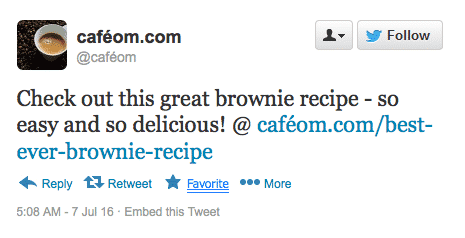
Before you know it, everyone is talking about the Café’s amazing brownies. At some point, those followers will decide to visit the café for real and there you have the conversion from virtual blog post to real-life customer (and money in the till, ca-ching!).
Reward, don’t Repel
I decided to subscribe to the newsletter of a certain fashion brand; I liked the clothes and thought that by following them online I’d be able to make the most of the occasional sale previews or discount codes. But after a month of my email inbox being inundated on an almost daily basis with promotions, I ended up unsubscribing. It was too much of the ‘hard sell’ with nothing for me to take away (that didn’t involve spending money). It would have been much more interesting, as a consumer, to have read articles less frequently but with more take-away information – What’s in this season? Where was the spring/summer campaign shot? Who was the photographer? Rewarding the consumer with this ‘inside-information’ in exchange for their time invested in following the clothing brand would have led to much greater engagement – the consumer will look forward to the email as a welcome distraction to the day, as opposed to being annoyed at the interruption to work.
Slow and Steady Wins The Race
It goes without saying that at some point, we want our ‘followers’ to spend with us. Whether it be converting the online Twitter follower of the museum to getting them through the actual door, or converting the travel blog reader to customer when they book a holiday through the travel blog’s website; just keep in mind the 4 out of 5 rule; inform, share, engage and educate your followers before promoting a product or service with your 5th post/tweet. We all know you can’t get to 4th base on a first date, right?! Relationships take time to develop – listen and respond with your output accordingly – the long-term benefits will be worth the effort!
Keeping people interested and engaged
In a digital age when there is masses of content generated on a daily basis, it is essential that you focus your attention on what interests and engages your target audience.
- What do they want to read?
- What information do they want to consume?
- What interests them and how do you connect with them?
The rise of Facebook and other social media platforms combined with the appetite for content has resulted in sites such as Friends Reunited losing their appeal and relevance.
When Friends Reunited was reunited (sorry) with its founder Steve Pankhurst, he realised that he had over 10 million people signed up but the data was old and people were using the website simply as a message board – people weren’t interested in using the site for it’s original purpose which is a clear sign of a lack of interest.
Evolving your activities to continually appeal and then maintain the interest of your audience is integral – keeping up with the changing requirements is a challenge but a challenge you must accept and address.
You need to keep abreast of changing habits by consuming similar information to your target audience whilst also talking to them to find out exactly what they want and how they want to consume content.
Keep people interested by sharing insights into your business, provide them with tips and information that they are able to go away and use. Participate in online discussions, this interaction will help you to understand what people find interesting and how they react to it.
No, thank you
As children we’re told to say ‘please’ and ‘thank you’. As an Adult I encourage this behaviour in my children so they will be seen as polite, helpful and well-rounded. There’s a perception that when this is not said one is considered rude.
This works well in verbal communications – it’s quick and there really is no extra effort involved. But in email or other text messaging politeness can drive me to distraction.
I’m not thinking of when I thank a client for trusting me with coaching their marketing team or praising individuals at the the end of a website project (I must do this more often) but the little niceties within day-to-day communication.
Examples such as: receiving an email reply from a client after I’ve just sent them a file or some requested information and thus pinging up another notification, or yes, another email to peruse and process. Or, using what little cognitive energy I have left to decide whether or not to reply to their ‘Thank you’ message with a equally amiable ‘My pleasure’ and in doing so, cause my client to be distracted by my notification.
Don’t get me started on how much email pre-amble I should use – When does it stop!
Thankfully Basecamp, a project management tool we rely on at Rather Inventive, introduced two ideas in their new software that have helped to reduce my stress levels, thus affording me more time to focus on the important communication, where it matters.
- Applause – Rather than thanking a person by typing a reply (thus treating the whole team to yet another message) you can click on a little ‘Applause’ link which sends a nod to the person that you’ve noticed their work. It’s a ‘like’ button for work stuff, and used sparingly it has impact.
- Campfire – A simple real-time text message between you, your team and your client that you can dip in and out of, doesn’t notify you of every message and stays out of the way when you need to focus.
So dear client or friend, if you think I’m being too curt or even possibly downright rude, know that I am actually saving you time by not creating another email for you to process.
—
Image credit: Basecamp 3
Things I learned while Periscoping
I thought it would be fun to share some lessons learnt while covering We Cycle UK’s WACC2016 (Women & Cycling Conference 2016). I was charged with capturing the day using Periscope, a live streaming mobile video app, by filming some of the speakers and delegates. I must admit video is not my day job but it was fun to do and I’ve learnt a lot.
Get up close and personal
When framing the shot before broadcasting Periscope only shows the top half of the video with the bottom obscured by the keyboard and broadcast button. I always felt I had framed the shot well at first but when broadcasting and seeing the full video it the interviewee looked too far away. Getting closer will also help the built-in mic pick-up their voice more clearly.
Time it right
Allow for a few seconds delay before speaking after you start broadcasting and when you finish leave a few seconds silence so that your words don’t get cut off. I constantly mis-timed this with the resulting video having the name of the person I was speaking to trimmed off, not ideal.
Front first
Periscope defaults to using the front facing camera (on my iPhone at least). So if you are going to record yourself while looking at the screen start the broadcast focused on something interesting for a five seconds or so before switching to the rear facing camera to start talking. It’s worth practicing this to get the timing right.
Tripod or not?
I used a tripod for almost all of my Periscope interviews. This worked really well to record my monologues or when I didn’t need to move the camera but given the conversation style of my interviews and occasionally filming 2 or more people moving between people speaking was slower than it would have been handheld. If I did the interviews again I would most likely hold the iPhone in my hand for almost all the footage.
Light them up
Bring a small LED light to brighten faces when interviewing. I was in a very dark space backstage for some of the interviews and didn’t leave enough time to organise better lighting. I thought I could use the iPhones flashlight but when you start a broadcast the LED get’s turned off. Eek.
Buy a battery pack
Using the camera with wifi or 4G radios going all day will burn through your battery. I used a large power pack from Anker with was permanently plugged into the iPhone but even having even a small power brick can help you relax into each interview without worrying that you phone will turn off.
Save to Camera Roll
If you have the space on your phone I recommend turning on the ‘Auto-Save to Camera Roll’ option in settings as Periscope videos currently only last 24 hours online before they are deleted.
If you have any other tips and ideas on Periscope please let me know on Twitter @BenKinnaird
—
Masthead photo credit: Anna-Therese McGivern
Accessibility and Email Campaigns
Following my interview with Bik Lee from the RNC I came across this helpful article on accessibility in email from Campaign Monitor in my reading queue.
Blindness and other degrees of vision impairment are more common than many would think. 285 million people worldwide are considered to be visually impaired
Worth reading for those who have a hand in the design of their email campaigns. Many of the points they mention also apply to website development and copywriting.
Periscoping, an interview with Jonathan Pollinger
I speak with Jonathan Pollinger, Social Media Expert who likes “Connecting people and watching the resulting magic”. We talk about his real world social networks, his thoughts on Periscope, a live streaming video app, and a 2 fundamental tips everyone should follow in any social interaction.
Follow Jonathan on @intranetfuture on Twitter and all other forms of social media or visit his website intranetfuture.com.
- Laptop Friday is an “informal co-working and networking event held every Friday morning in Smokey Joe’s on Bennington Street in Cheltenham”
- Cheltenham Connect is the “fastest growing and most active initiatives in Cheltenham […] with the aim of strengthening and empowering the residential and trading community”
- Laptop Monday is an “evening coworking and networking meeting for anyone who enjoys working out of a cool and funky coffee shop.”
- Periscope “Explore the world through someone else’s eyes.”
- King Shots Coffee, experimenting with video training with Chris the owner
- Twilert.com “Twitter search alerts made easy”
A blog is your company’s shop window – use it!
There’s a shop in our local town that never changes its window display. The mannequins look faded and jaded, bored of being stood there for weeks, months and years on end. Needless to say the shop is always empty because nothing is tempting customers inside.
Like a shop window, a blog has the power to entice viewers to sample the delights your company offers, and give a taste of your company philosophy and ideas. It enables you show off new products and services and share valuable content about the industry. A regular blog shows that you care about keeping your audience informed of progress and changes, and each post you publish is an asset that helps to build your brand. Your blog should be at the heart of all of your content marketing efforts.
Add credibility
A regular blogs enables you to share your expertise and position your company as a leading authority in your subject area. If you so choose it can serve as a reliable resource for information about your industry. And you can add credibility to your blog and therefore your business by inviting external specialists, clients, and industry experts to write guest posts, which will serve to support your reputation as a company at the forefront of the industry.
Impress your influencers
Each time you publish a blog post you create another opportunity for your site to be shared and circulated on social media, getting exposure to a potential new audience. Influencers are those people who like to sing the praises of companies they have connected to and respect, and are invaluable in that they’ll shout your company name from the rooftops, (I like to imagine them as the modern equivalent as the sandwich board boys of Victorian times) Give your influencers something worthy of their valuable attention and they’ll share it with others.
Encourage interaction
A comments and feedback option on your blog effectively gives you a two-way conversation with customers, prospects and industry peers, which can give you both valuable market intelligence and support for your ideas. Always respond to these comments promptly and positively, because others will read them and know you are a company that cares for its audience.
Analyse
Subscribers to your blog are a ready-made audience for your articles, newsletters and announcements on industry-relevant topics. And you can use this to your advantage to gain an insight into your audience. Through ‘analytics’ you can track readers’ activities including click-throughs, popular topics, frequency of views, shares and comments.
Schedule regular valuable content
Giving your readers relevant and timely content is key to a successful business blog and a prime way of establishing you as a leading authority in your industry. If you’re stuck for a topic then writing about the ‘who’, ‘what’, ‘when’, ‘how’, and ‘why’, of your business is a good place to start. Give your readers blog posts that are informative and answer any questions they might have on an industry-specific subject. Make your business the go-to guy for your industry and the solution to their problems.
Have a successful blog? Send us your comments on Twitter. Need an appraisal of your blog? We’d be happy to help. Do get in touch.
Ted Wright on Word of Mouth
Brilliant interview with Ted Wright about how to work with influencers and encourage word of mouth marketing.
“Influencers can’t be bought, they will refuse cash…”
“Influencers, it’s not a job title, it’s not a job description, it’s a personality trait…”
Ted goes on to list the 3 personality traits of an influencer:
1. Like to try new things because they are new
2. Intrinsically motivated
3. Love to share stories with their friends
“The reason they are intrinsically motivated is because they do like to share stories with their friends“
I encourage you to listen to the entire interview which has a few examples of how to benefit from influencers. It’s only 34 minutes and you can even speed it up in the web player. I’ve not read his book “Fizz” yet so cannot say if it’s as good as I found the interview.
For those keen on developing word on mouth as a marketing strategy, I’d also recommend listening to Seth Godin’s “Purple Cow”. which covers some excellent concepts and ideas. Seth however likes to call “influencers”, “sneezers” that spread an “idea virus” – Cute.
Twitter noise
Once upon a time, all the Twitter experts advised us to Tweet, tweet, tweet. We need to get out into the Twittersphere, they said.
But now, for some, the incessant noise from Twitter can be somewhat overwhelming. Their feed is so busy that they cannot ascertain which tweets to take notice of. They believe that a drip feed rather than a fire hose would be more appropriate; a filter to ensure all the superfluous material doesn’t make it through to their consciousness, clogging up brainspace and interrupting what they really want to see.
This is certainly the view of Gary Vaynerchuk social media expert, author and entrepreneur who spoke at the Guardian Changing Media Summit in London and said that 5 years ago Twitter users would pay a lot more attention to what was being said on Twitter in general, and more people paid attention to them too. Since then he believes that Twitter has become too ‘noisy’.
There is such a thing as over-tweeting. But you can avoid being one of those Twitter accounts that indiscriminately spews self-promotion announcements and blatant marketing material left right and centre by being selective in what you choose to Tweet. Its true, the more you engage in discussion and information exchange on Twitter, the more exposure you will receive. But, make your Twitter updates interesting and useful. Use Twitter to engage with your audience. And build relationships by ensuring your Twitter stream promotes other people and businesses too. Share links, retweet interesting updates, join conversations and answer questions.
The shortness of a Tweet means that the information you are broadcasting must be concise. Too many companies treat Twitter like a fishing line, regularly throwing out any old rubbish and seeing who bites. Too much drivel just to get the exposure means that you may find that people avoid you, or worse, unfollow or mute you, whereas compelling Tweets with links and resources can attract followers through to your website, which might just turn them into valuable customers.
—
Photo credit: https://www.flickr.com/photos/affsum/3231433003/
GDA Deaf Awareness video campaign interview
Another interview for my Epic Win talk at the Going for Growth networking event was with Gemma from Gloucestershire Deaf Association to find out why their Deaf Awareness video campaign was such a success.
Your organisation in 140 characters
Gloucestershire Deaf Association enables deaf and hard of hearing people to live independently, without fear, isolation or barriers. (that’s 132, well done!)
How did you come up with the idea
The idea of the videos was the brainchild of my colleagues James and Reg, both of who star in the videos. Reg is profoundly deaf and James is a fully qualified British Sign Language (BSL) interpreter so both have a very in-depth understanding of where deaf awareness is lacking. We were able to produce the videos thanks to some funding from a grant from the Lloyds TSB Foundation – the videos were the finale of the ‘Money Matters’ project that had been running over the last two years thanks to their funding.
What was the intended outcome and did you meet it?
The intention was to get the ball rolling for Gloucestershire to become the most deaf friendly county in Britain. Through the series of videos we hoped to reach as many businesses, groups, individuals as possible with simple and effective ways that could make them and their businesses more deaf friendly. Yes, I think we did, we certainly got the idea of deaf awareness out there thanks to the videos, social media and press coverage.
Was a series of videos better than just one?
I think so, each of the videos had the benefit of being short and concise meaning we could capture people’s attention much more. If we’d put the collection into one I don’t think we would have engaged as many people as we did. The series of videos meant we’ve been able to get across a number of simple messages rather than just one.
What channels (Twitter, Facebook, Email, word of mouth etc) did you promote the videos on? And which worked best?
The videos were uploaded onto Youtube and distributed mainly through Twitter. For us, Twitter offers a much wider audience. Our audience on Facebook is generally people GDA works with, so while it’s valuable they see these videos, given the objectives of the series it was important for us to use whatever means we could to reach a wider audience; local businesses, groups etc. Over the five weeks the five videos were viewed collectively 7,530 times, links to the videos were retweeted 719 times and we received 219 mentions specifically about the videos. Our highest viewed video was ‘Dave the Signer’, our first film which has been viewed over 3,840 times to date. Considering the average number of views for our videos is about 100 these figures are a huge success.
How important is humour in the videos?
We use humour a lot. We’ve found that our audience – mainly Deaf BSL users respond best to something that’s engaging and a little different from the videos that are normally thrusted at them. We get a much better response to the videos when we’ve incorporated Reg’s unique humour into them.
Have you seen an increase in website visitors, followers, likes?
We have yes, our YouTube subscribers have shot up from 11 to 68 at last count. Our Twitter and Facebook followers have both also increased and we’ve noticed a distinct increase in traffic: 24.51% more users while page views went up by 10.68%.
Any unintended consequences?
In response to the videos we’ve been able to make contact with a number of key figures including the Senior Equalities Manager for the NHS, Gloucestershire’s Police & Crime Commissioner as well as being invited to present deaf awareness to local groups.
Why use video over text?
Because video is so much more accessible to a Deaf BSL user. One of the misconceptions about a deaf person is that by writing something down you will break down the oral barrier – I myself used to believe this. However, for a Deaf BSL user, BSL is their first language, English is their second. In comparison to BSL, English is very complex – BSL doesn’t faff about with tenses or words like ‘the’ so to include those in text makes the message very inaccessible to a deaf person, getting these deaf awareness messages across on video meant we were being inclusive to our service users and leading by example.
What have you learnt from the campaign?
We’ve yet to have a full debrief session of the campaign, but personally I would perhaps consider releasing the videos closer to together, I don’t think we needed to have the week gap between each one. I think that way we may have caught people’s attention for longer and have continued the viewing figures of ‘Dave the Signer’ into the other videos.
What’s next?
What isn’t next!! As part of our overall campaign for Gloucestershire to become the most deaf friendly county we will be hosting a pre-election debate on the 16th April where Gloucester’s general election candidate will present their policies to our service users and who in turn, will have an opportunity to quiz them on matters that matter to them – if we can make local politics deaf aware we’re on the right road. We’re also going to be continuing to press for more local businesses to be more deaf aware by taking on board our simple tips and our next big campaign will be a campaign aimed at schools called ‘My Friend Dawn’. Using fun and interactive class room activities we want to make the younger generation more aware of how to be deaf friendly. All this is happening in the next three months so it’s a busy time at GDA!
Follow the GDA YouTube Channel, @glosdeaf on Twitter or find out more on their website www.glosdeaf.org.uk.
#MakeMyPersona Campaign interview
As part of my Epic Win talk at the Going for Growth networking event, I spoke with Lisa Toner from HubSpot on which marketing channels worked best for their MakeMyPersona Campaign.
Your organisation in 140 characters
HubSpot is an inbound marketing software company that provides valuable and educational content that helps marketers become more effective (that’s 138, close!)
How did you come up with the idea
Buyer personas is the first step in getting started with inbound marketing but it’s a step that many people skip in order to do more fun and sexy marketing activities. I wanted to try and remove some of the friction for marketers by making it quicker and easier to create their personas.
What was the intended outcome and did you meet it?
The goal of creating the persona tool was to generate new subscribers for HubSpot and then convert them into leads. We surpassed the goal we set within the first week.
What channels (Twitter, Facebook, Email, word of mouth etc) did you promote the videos on? And which worked best?
We promoted the tool via email, social, blog, guest posts, and communities like inbound.org. Out top sources of traffic to the tool were: Email (23%), Direct: 20%, HubSpot blog (18%), LinkedIn (13%), Referral (6%), Twitter (3.5%), Organic.
Have you seen an increase in website visitors, followers, likes?
Yes, we used an exit-intent pop-up which drove traffic back to the HubSpot site to a relevant landing page which has generated over 1,000 conversions on that page.
Any unintended consequences?
Our sales team told us that a lead using that tool was more valuable to them for having meaningful conversations than if the lead had requested a demo or trial.
What have you learnt from the campaign?
On the next round I would think about how to integrate it more tightly with our product and show that off a little more.
What’s next?
We are translating it into 3 languages; spanish, german and portuguese.
Go ahead and make your own persona at www.makemypersona.com.
Follow @hubspot on Twitter or find out more on their website www.hubspot.com.
Epic Social Media Win (not fail)
The best and worst social media campaigns for ideas and inspiration in your online marketing.
Slides from my presentation at Going for Growth, a Worcester Business Central event on 17 March 2015.
—
Image credit: BBC Epic Win, http://www.bbc.co.uk/programmes/b012f6pl
Exploring Social, an Interview with Dr Cat Arthurs
Dr Cat Arthurs, partner at Towcester Vets in Northampton explains how getting involved in social media and blogging has been amazing opportunity for their partnership leading them to become “go-to” experts appearing on radio and tv.
Find out about Towcester Veterinary Center on Twitter, Facebook or thier website.
- Malmo, where The Bridge is filmed and where Cat was born
- Alabama Rot, a mystery disease
- Buffer App
Help others to help yourself
The best way to build your social network and to win followers and advocates is to reach out to support others in whatever way you can. Do the talking for them and there’s a good chance they’ll reciprocate.
When you say positive things about other companies, you help to bolster their reputation and build up their brand. For example, re-tweeting or sharing what others in your network say, especially if you’re highlighting their unique skills or offering information about what distinguishes them from others in their particular market, is a good way to help promote their business. And, not only does it enable you to connect with the company you are promoting but this seemingly altruistic action will have lots of lovely benefits attached. In the process of promoting others you’ll be indirectly promoting yourself because the more you say nice things about others and highlight their accomplishments, the more they’ll love you for it and the more likely they’ll reciprocate.
So why does this happen? Well, think of it this way, if you go round telling everyone that you’re great at tennis, they’ll be inclined to think you’re bragging a bit and will likely want to see the proof before they believe you, (and even then they’ll think you’re a bit conceited). But, if one of your acquaintances, colleagues or buddies goes around telling everyone you’re great at tennis, they’ll more likely be believed, right? And you’ll be known as the guy or gal who’s great at tennis. So, any endorsement or approval of others that you offer will come across to third parties as more genuine than self-promotion, and the company in question will be eternally grateful.
I like to think of it as ‘credits in the bank’, very few people will walk away if you’ve helped to bolster their reputation, instead you’ll find that the majority of people will be only too pleased to help promote you in turn and form a mutually beneficial alliance. It’s a win win!
Discovering her Bounce an Interview with Nicky Marshall
While on a diving holiday Nicky suffered an accident that changed her life. I find out how she pieced her life back together. She also shares some advice on marketing including the power of 3!
Contact Nicky on Twitter, Facebook or her website.
(We recorded the interview in Chiquito’s restaurant in Bristol and as such there is some background noise)
- Witches brew Fairtrade tea and coffee, gorgeous gluten-free cakes and a range of lunchtime panini and soups – Yum!
- Discover Your Bounce Helping people who lack energy and direction
- NPR Snap Judgement Story telling with a beat – Brilliant
- An Everyday Witch Nicky’s self published paperback
- CompletelyNovel Self publishing and reading community
- Damsels in Success Lianne O’Brian scooped Woman to Watch/Rising Star!
- Chiquito’s in Bristol Thanks for the wonderful atmosphere and coffee grinding
- 4N Longwell Green, Bristol
Being sociable on social media
Look it up in Wikipedia and the very first definition of Social media is the interaction among people in which they create, share or exchange information and ideas in virtual communities and networks.
Most of us know how to act when we are out socialising in the physical world, but with social media being such a new thing, relatively speaking, can we be sure that we’re engaging with people in a way that optimises exposure?
If we approach social media in the same way we might approach, say, going to a network event or even a party, we can’t go far wrong.
Engage with people – we wouldn’t stand at a party talking like an automaton would we? A few strange looks might ensue. No, we’d talk naturally, casually, explaining any technical details of our work to ensure people don’t glaze over or phase out with boredom. The same goes for social media – talk like you would to a real person (minus the Ums and Ahs) and you’re more likely to get real responses.
Be where the party is – Everyone who is anyone will be at that new Networking event in the city tonight, right? So, by the same token find out where the best people hang out online and join them, making sure you discuss topics you know they’ll be interested in.
Break the ice – At an event you don’t hang around waiting for someone to come and talk to you, you could be waiting a long time, instead you’ll get right in there, wont you? Be the first to comment on an interesting tweet, or share a blog post of your favourite company for a little bit of audience love.
Dare to be different – the one way to stand out at a party/networking event is to do something different. Wearing a DJ at a relaxed social event will get you noticed for sure. So, be creative to attract attention on social media. Innovative companies do new and exciting things and are not short of a follower or two, take a leaf.
Voice your opinion – say nothing at a networking event and people will quickly pass you by looking for a more interesting prospect, be opinionated and the crowds will flock to you. Need we say more?
From Cobol to Conferences an Interview with Joel Hughes
Joel’s worked on main frames, web programming, design and now run’s his own conferences – He’s a true Tinkerer. Ben finds out about his events, accessibility, Mac setup and some advice on running events amongst many other things.
Contact Joel on Twitter, Instagram or his website.
- Port80 Conference. Speakers include: Denise Jacobs, Joshua Marshal, Kevin Evans
- Minority Report iBeacons advertising reference
- AbilityNet Accessibility Assessment
- LocalHost Events Mini Port80 events that run quarterly
- The Business of Web Design Conference
- ShropGeek
- RedBooth project manager, Project Management Post by Darren Beale
- Harvest time tracking
- Quote Roller quote program
- Touch points
- Highrise CRM
- OnePageCRM

